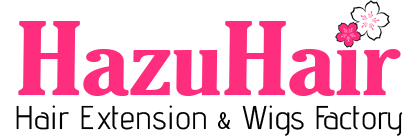Hair knowledge
Balayage vs Highlights Hair Color – What’s The Difference?
If you’re considering a change in your hair color and looking for a fresh new style, you may find yourself asking: balayage or highlights? Both techniques are among the most popular choices for hair coloring and can create beautiful results. The good news is that balayage and highlights can be applied to both natural and previously colored hair, regardless of whether your hair is light or dark.
To make an informed decision about your hair coloring, it’s essential to understand the differences between balayage and highlights.
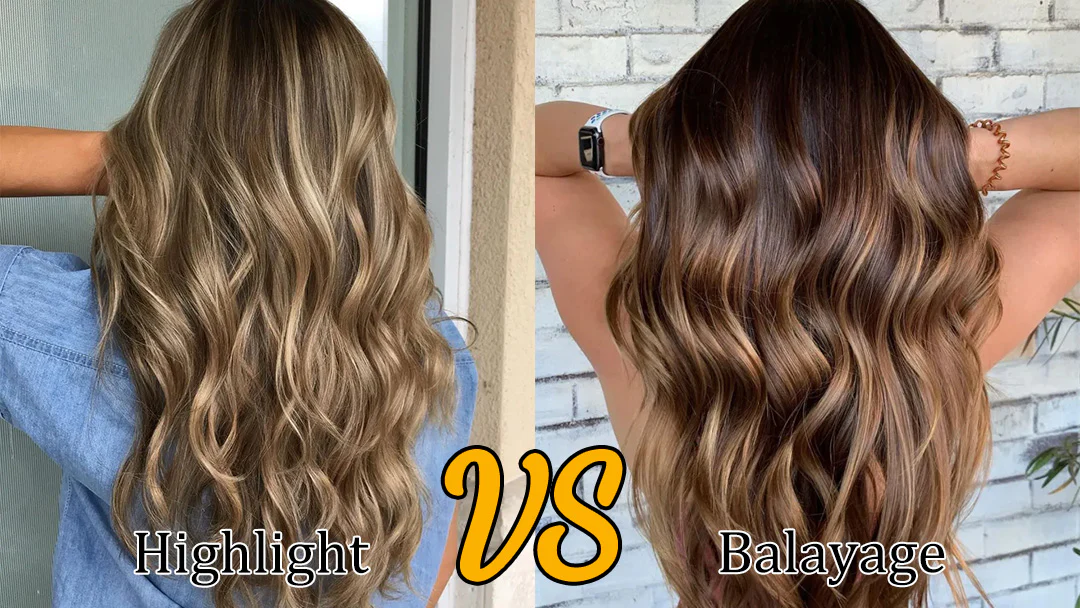
What is Balayage hair color ?
Balayage is a hair coloring technique where stylists hand-apply color to random sections of hair. The term “balayage” is derived from the French word “balayer,” meaning “to sweep.” This method typically involves sweeping color or lightener onto the hair, starting from the mid-lengths and becoming more concentrated towards the ends. The result is a natural, sun-kissed glow that blends beautifully into the hair.
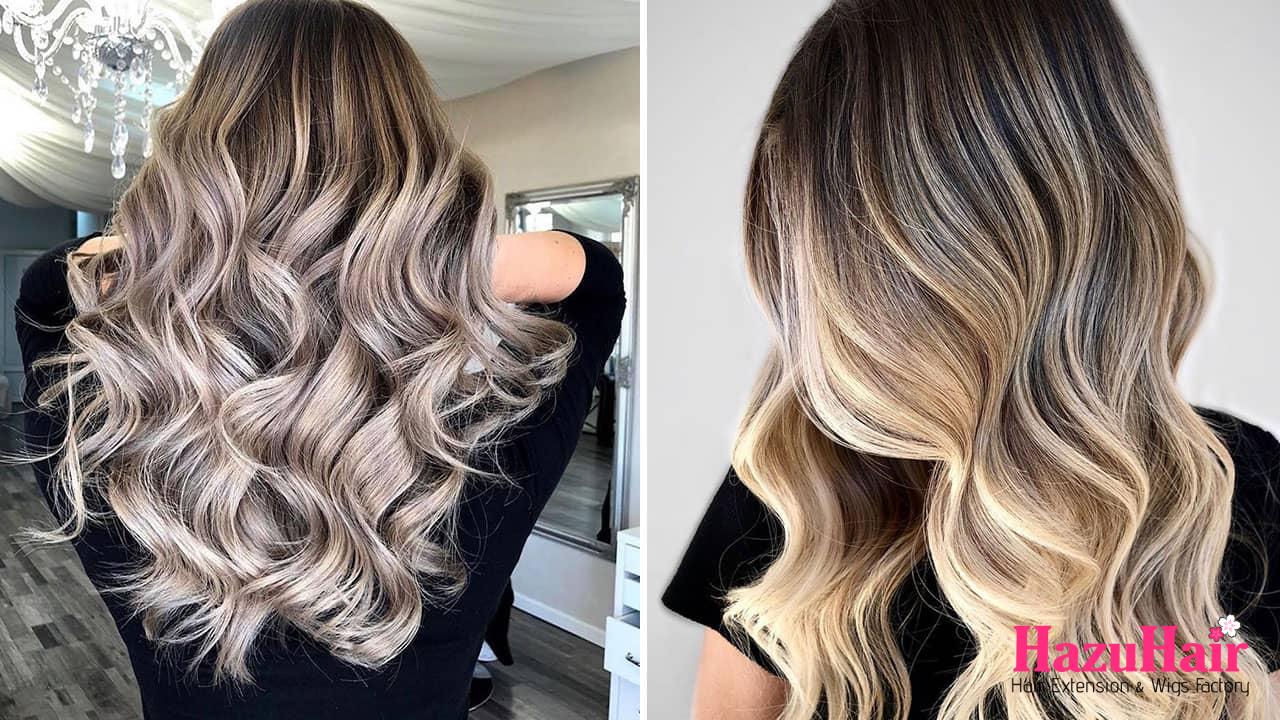
Types of Balayage
There are various balayage techniques you can use to achieve different hairstyles and looks. Here are some popular options:
- Full Balayage: This technique involves applying color throughout all of your hair, creating an overall lightening effect. It’s perfect for a complete color transformation.
- Partial Balayage: In contrast to full balayage, this technique highlights specific sections of the hair, creating a spotlight effect. It combines traditional foiling with balayage, where the stylist paints on the highlights and then covers them with foil to intensify the color.
- Flamboyage: This method uses adhesive strips to create a blend of highlights and lowlights, resulting in a multidimensional effect.
- Babylights: This technique involves applying fine, delicate highlights to small sections of hair, creating a subtle, natural appearance.
- Reverse Balayage: Opposite to traditional balayage, this technique transitions your hair color from lighter to darker tones. It’s an excellent choice if you want to return to a darker or more natural hair color.
How Long Does Balayage Take?
The balayage process includes several steps that can vary in duration. The total time required depends on factors such as your desired outcome, hair length, thickness, texture, and the stylist’s expertise. After consulting with your stylist about your desired look, the freehand painting technique can take anywhere from 30 to 60 minutes, depending on your hair’s density and length.
Once the coloring is complete, you’ll typically wait about an hour for the application to process. After that, the stylist will apply toner and other haircare products to protect your hair and enhance the balayage effect.
Overall, the balayage process can take between 90 minutes to 3 hours. With proper care and the right quality products for colored hair, balayage can last up to four months.
If you’re looking for an experienced salon for your balayage, consider visiting Yukie Natori Salon and Spa in NYC.
What Are Hair Highlights Hair color?
Hair highlights refer to a coloring technique that involves using bleach or a lightening agent to create lighter strands within the hair. This technique can be applied to any hair color, enhancing the contrast against the base or natural hair color. The result is a brighter, more dimensional look that adds depth and vibrancy to the hair. Highlights can range from subtle to bold, depending on the desired effect.
During the highlighting process, hairstylists typically wrap the hair strands in aluminum foil to help intensify the lightening effect.
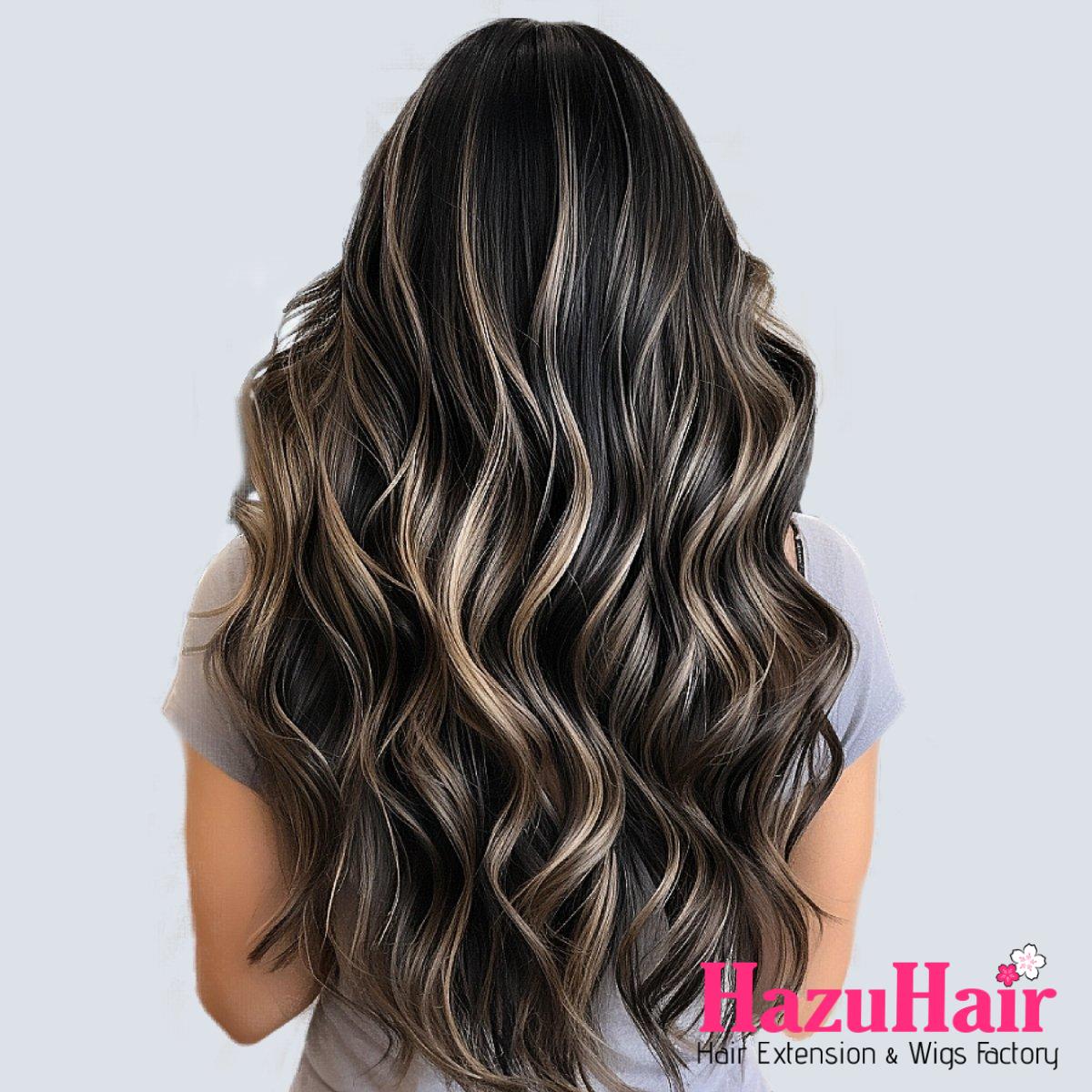
Types of Highlights
There are several types of hair highlights, each offering a unique look:
- Traditional Foil Highlights: This classic method involves weaving sections of hair, applying a lightening solution, and then covering the strands with foil. This technique intensifies the color and creates a well-defined highlight.
- Chunky Highlights: For those seeking a more pronounced change, chunky highlights provide visible, bold sections of color. This technique creates a dramatic contrast and can make a striking statement.
- Peekaboo Highlights: This technique involves creating hidden lighter strands of color beneath the top layer of hair. Peekaboo highlights offer a fun and unexpected twist to your hairstyle, revealing color only when the hair moves.
- Babylights: Babylights consist of superfine, delicate highlights distributed throughout the hair to achieve a subtle, natural effect. This technique is perfect for transitioning from natural to color-treated hair without a drastic change.
Highlighting Techniques
There are two main highlighting techniques based on the amount of hair colored and the resulting look:
- Full Highlights: This method involves lightening every strand of hair from the roots to the ends, resulting in an all-over, bold, and dramatic look. Full highlights are ideal for those wanting a complete color transformation or those with naturally darker hair seeking a lighter appearance.
- Partial Highlights: In contrast, partial highlights focus on coloring only specific sections of hair, typically the top layer or selected parts, while leaving the rest natural. This technique is great for individuals wanting a more understated and low-maintenance look, enhancing their natural color with subtle lightening.
How Long Does It Take to Get Highlights?
Adding highlights and layers to your hair involves a multi-step process that can take several hours. Here’s a general overview of the time involved:
- Full Highlights: Typically, full highlights can take between 2 to 4 hours. This duration accounts for sectioning the hair, applying the lightener or color, allowing the hair to process, rinsing out the product, and toning if necessary.
- Layering: The time required for layering or cutting your hair can range from 20 minutes to an hour. This varies depending on the complexity of the cut, as well as the thickness and length of your hair.
In total, you should anticipate spending around 3 to 5 hours at the salon for both services. Keep in mind that this is a general estimate and may vary based on your stylist’s speed and technique, your hair type, and the specific services you choose.
Comparing Balayage vs Highlights Hair color
Balayage vs Highlights: The Similarities
Balayage and highlights share several similarities that often lead to confusion. Here are some of the key similarities between these two popular hair coloring techniques:
- Color and Dimension: Both techniques enhance hair by adding color and dimension.
- Professional Application: They are best performed by professionals in a salon setting.
- Need for Touch-Ups: Both require touch-ups after a period, as the effects are not permanent.
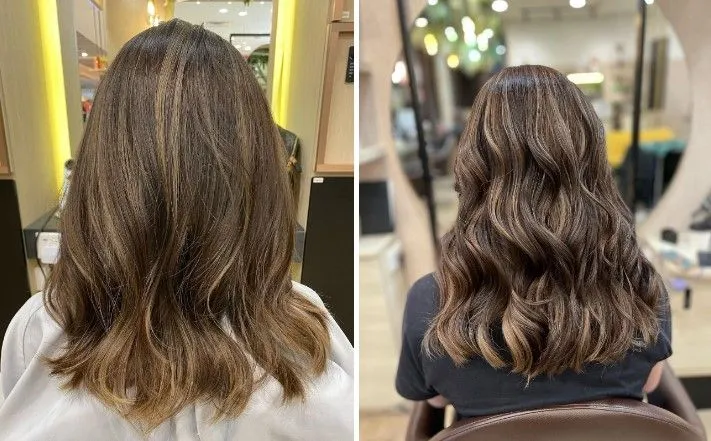
Balayage vs Highlights: The Differences
While balayage and highlights have some commonalities, they differ significantly in several aspects, including application technique, damage potential, results, and maintenance. Here’s a closer look at these differences:
- The Technique: Balayage is a freehand painting technique, whereas highlights typically involve using foils. This distinction in application results in different outcomes: balayage tends to produce a more individualized look, as the color is hand-painted in sweeping strokes, while highlights create a more uniform appearance due to the sectioning process.
- The Damage Risk: In terms of potential damage, balayage is generally more harmful to the hair. To achieve that sun-kissed effect, dark hair often requires multiple bleaching sessions with a high-volume developer, making balayage a higher-damage technique. However, highlights can also cause damage, especially since they involve bleach and foils. The extent of damage can be managed by opting for darker or low-lighting highlights.
- The Result: The results are perhaps the most significant difference. Balayage aims for a natural look, resembling hair that has naturally lightened in the sun, and usually appears more subtle. In contrast, highlights are designed to create a more noticeable and sometimes dramatic effect, resulting in a more striking change.
- The Maintenance: Balayage is considered low-maintenance, as it grows out more seamlessly, making the transition less noticeable. In contrast, highlights require more frequent touch-ups because the contrast between the colored hair and natural roots is more apparent, which is why many people prefer balayage over highlights.
- The Price: Typically, balayage is more expensive than highlights due to the technical skill required for the application. Prices for balayage can range from $100 to $400 or more, depending on hair length and stylist expertise. Highlights, on the other hand, are usually more affordable, costing between $50 and $150.
- Longevity: On average, balayage lasts up to four months before requiring a touch-up, which is significantly longer than traditional highlights, which often need refreshing within a few weeks. Choosing balayage can therefore be more cost-effective in the long run due to less frequent salon visits for maintenance.
Which One is Right for You: How to Choose Between Balayage and Highlights
Now that you’re familiar with the key differences between balayage and highlights, it’s time to determine which option suits you best. Here are some considerations to help you make your choice:
- Desired Look: Do you prefer a natural appearance or a more dramatic effect? If you’re leaning towards a subtle, sun-kissed vibe, balayage is the way to go. For a more striking transformation, highlights would be your best bet.
- Budget Considerations: Are you open to spending more for a longer-lasting color? If so, balayage is ideal. However, if you’re working with a tighter budget, highlights might be a more practical choice.
- Hair Condition: Do you have damaged hair? If your hair is in poor condition, it’s best to avoid bleach and high-volume developers. If you still want to lighten your hair, highlights may be the safer option, but aim for shades that aren’t too light.
Your responses to these questions should provide clarity on which hair coloring technique aligns with your needs. If you’re still uncertain, consider scheduling a consultation with a professional hairstylist. They can evaluate your hair’s condition and offer personalized advice.
Considering Wigs as an Alternative
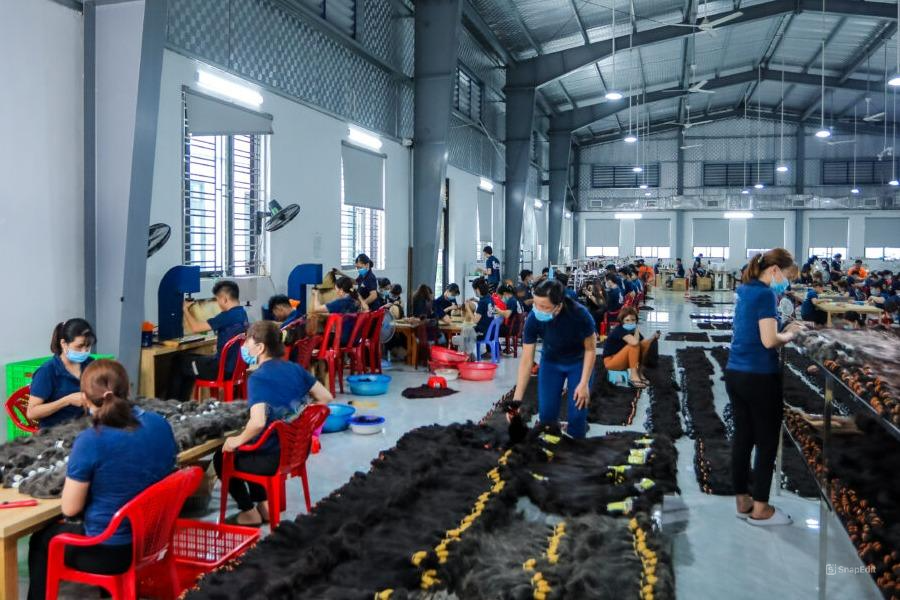
It’s worth noting that wigs are a fantastic option to explore. They provide the flexibility of changing your hair color without any damage to your natural hair. With wigs, you can switch up your style as often as you like, enjoying a new look without the risk of harm.
If you’re seeking a damage-free way to experiment with hair color, wigs are definitely worth considering. We offer a great selection of top-quality human hair wigs for you to browse. Find the perfect highlighted or balayage unit that suits your style today!
Contact HazuHair – Raw Vietnamese Hair Supplier
- Hair Factory: Tan Son 2 Village, Tan Dinh, Lang Giang, Bac Giang Province, Vietnam
- Hotline: +849 4949 3883
- Whatsapp Mrs ThanhLam: https://wa.me/84949493883
- Website: https://hazuhair.com
Frequently Asked Questions (FAQ)
What’s the difference between balayage and highlights?
Balayage is a freehand technique in which color is painted onto the hair to achieve a natural, sun-kissed appearance with softer regrowth lines. In contrast, highlights involve sectioning the hair and using foils to isolate strands, resulting in more distinct and uniform streaks of lightened hair from root to tip.
What are the benefits of choosing balayage over traditional highlights?
Balayage offers a more natural-looking finish, less noticeable regrowth, and typically requires less maintenance since it doesn’t need as frequent touch-ups as traditional foiled highlights. This can also contribute to less damage over time.
Who is the ideal candidate for balayage?
Balayage is versatile and suitable for various hair types, textures, and colors. It’s especially ideal for individuals seeking a low-maintenance style, subtle color enhancement, or a more natural look. The technique can be customized to meet individual preferences.
What are the potential drawbacks of balayage?
One of the main drawbacks is the cost; balayage can be more expensive upfront due to the skill and time required. Additionally, it’s essential to find a stylist proficient in the technique to ensure optimal results.
What’s involved in the traditional highlighting process?
Traditional highlights entail applying hair color to specific strands and wrapping them in foil. This isolates the strands from the rest of the hair, allowing the color to process evenly and creating a more uniform brightness from root to tip.
What are the key benefits of highlights?
Highlights can dramatically alter your appearance, add dimension, and provide a consistent pattern. They are also effective for covering gray hairs or adding bright, well-defined streaks of color throughout the hair.
Who should opt for traditional highlights?
If you’re looking for a more noticeable, uniform color lift, want to cover significant gray hair, or prefer regular, patterned highlights, traditional foil highlights may be the right choice for you.
What limitations should one consider when getting highlights?
Highlights often require more maintenance, necessitating touch-ups every few weeks to manage regrowth. The process can also be more damaging due to frequent bleaching or dyeing, especially if your hair is delicate or already damaged.
How should I choose between balayage and highlights for my hair?
Consider your lifestyle, maintenance preferences, and the desired end result. Balayage provides a more natural, lived-in look with easier upkeep, while highlights can deliver a more dramatic and defined color change but typically require more frequent salon visits.
Can you tell the difference between balayage and traditional highlights?
Generally, balayage results in a more gradual, sun-kissed effect, while traditional highlights produce more contrast and uniform lines. Balayage blends seamlessly with your natural hair, whereas highlights tend to be more uniform and can extend from the roots to the ends of the hair.
